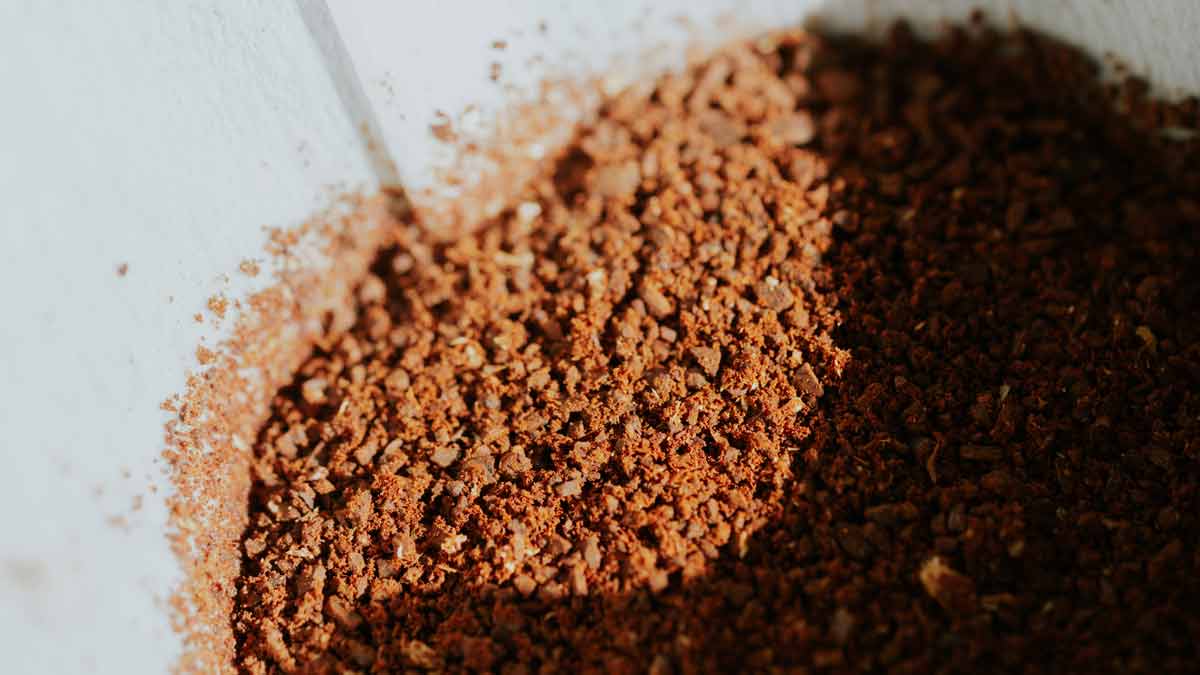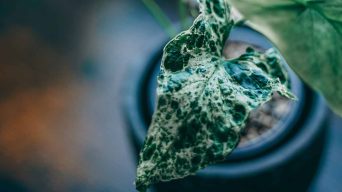Calathea plants, also known as the prayer plant, are popular houseplants thanks to their colorful foliage and low-maintenance care requirements. Although they are easy to care for, Calatheas can be prone to specific issues like yellowing leaves or low humidity levels.
To help ward off these common problems, many plant owners opt to fertilize their plants with an organic option like coffee grounds.
But are coffee grounds good for Calathea plants?
There are some potential benefits and risks to consider before using this fertilizer option on your Calathea. Here’s a look at both sides of the story.
The Benefits of Using Coffee Grounds on Calathea Plants
There are some key benefits to using coffee grounds as fertilizer for Calathea plants.
Here are some of the advantages of using coffee grounds on Calathea plants:
1. High Levels of Nitrogen, Which Is Essential for Calathea Growth and Healthy Leaves
Nitrogen is an essential nutrient that helps support the overall health of your Calathea plant. It’s critical for supporting leaf growth and keeping the leaves looking vibrant and green.
Fortunately, one of the main components of coffee grounds is nitrogen. A cup of coffee grounds contains around 2.7 grams of nitrogen, making it an ideal fertilizer for Calatheas.
2. Added Organic Matter to the Soil, Which Improves Soil Structure and Water Retention
Organic matter like coffee grounds helps improve the structure of your potting mix by providing valuable aeration and drainage. This helps improve the soil’s water retention and prevents Calatheas from becoming overly saturated.
Additionally, organic matter helps the soil retain moisture for longer periods and reduces water loss. This is especially important during hotter months when Calatheas require more frequent watering.
3. Potential to Deter Pests and Diseases
Coffee grounds have the potential to act as a natural pest repellent and help to prevent diseases from developing on your Calathea plants. This is because the caffeine in coffee grounds is toxic to many common garden pests, including aphids and mites.
It can also help reduce fungal infections, like powdery mildew and root rot, which can damage your Calatheas.
Potential Downsides of Using Coffee Grounds on Calathea Plants
While there are some potential benefits to using coffee grounds on Calathea plants, it’s also important to be aware of the possible drawbacks.
Here are some of the risks associated with using coffee grounds on Calathea plants:
1. Possible High Levels of Acidity, Which Can Be Harmful to Calathea Plants
Calathea plants prefer a slightly acidic to neutral soil pH, and too much acidity can be harmful.
Coffee grounds are naturally acidic and may push the pH of soil too low for the plant’s health. As such, it is recommended that you use coffee grounds sparingly and regularly monitor the pH level of your soil if you choose to use them.
If your Calathea plant leaves start to yellow or curl, the soil pH may be too low, and you should discontinue using coffee grounds.
Additionally, flush the soil periodically with water to ensure that salts do not build up and further harm your plant.
2. Potential for Mold or Fungal Growth if Coffee Grounds Are Not Applied Correctly
Due to its high moisture content, coffee grounds can easily harbor mold and fungal growth if not applied correctly.
To avoid this risk, thoroughly dry the grounds before adding them to your soil. It is also important to avoid overwatering, as this can further increase the risk of mold and fungal growth.
Additionally, avoid adding too much coffee grounds to your soil, as doing so can reduce aeration and drainage in the soil, which also increases the likelihood of mold or fungal growth.
3. Risk of Overfertilization Due to High Nitrogen Content
Coffee grounds are high in nitrogen, which can benefit Calathea plants. However, if not used carefully, it can overfertilize your plant and cause damage or even death.
As such, monitor the nitrogen levels in your soil and use coffee grounds sparingly as a supplement to other fertilizers.
It is also a good idea to flush the soil with water periodically to help avoid any buildup of excess nitrogen that could harm your plant.
How To Use Coffee Grounds on Calathea Plants
Knowing the potential benefits and risks associated with using coffee grounds on Calathea plants, you can decide if it is an appropriate supplement for your plant.
If you choose to use coffee grounds, here are some tips on how to do it correctly:
Fresh vs. Used Coffee Grounds
Fresh coffee grounds are generally more acidic and contain more nitrogen than those that have been used. Therefore, if you choose to use them on your Calathea plants, only add a small amount at a time and monitor the soil pH regularly.
Used coffee grounds are slightly less acidic and may be better suited for Calathea plants. However, it is essential to ensure that the grounds have been thoroughly dried before adding them to your soil.
Additionally, note that used coffee grounds may contain sugar or creamers, which can cause mold and fungal growth in your soil if not properly managed.
Dry vs. Wet Coffee Grounds
Always opt for dry coffee grounds over wet ones, as they are less likely to harbor mold and fungal growth.
If you have fresh coffee grounds that you would like to use on your Calathea plants, spread them out and allow them to dry thoroughly before adding them to the soil.
Damp coffee grounds could potentially cause issues with the soil, such as compaction or anaerobic conditions, so it is best to avoid them.
Mixing Coffee Grounds With Other Organic Matter or Fertilizer
Mixing coffee grounds with other organic matter or fertilizer can give your Calathea plants the necessary nutrients. Coffee grounds are rich in nitrogen, phosphorus, and potassium—all important for healthy plant growth.
When mixed with other organic materials such as compost or manure, they create a balanced fertilizer that helps support the health and vigor of your Calathea plants.
Additionally, adding organic matter to the potting mix helps improve its texture, allowing for better drainage, water retention, and aeration.
Mix equal parts of both materials in a container or bag to make a fertilizer with coffee grounds and other organic matter. You can also add in a water-soluble fertilizer to provide an additional boost of nutrients.
Once you’ve mixed the ingredients, spread it around the base of your Calathea plant and gently work it into the potting soil. This will ensure that your plants have access to all the essential nutrients they need for healthy growth.
Amount of Coffee Grounds Used
When using coffee grounds for calathea, be sure to use a small amount. The optimal ratio is one teaspoon of coffee grounds per gallon of soil. It’s important not to overuse the mixture, as too much can lead to nitrogen toxicity in your plants.
If you’re unsure how much to use, start with a small amount and monitor your plant’s response. You can always add more if needed.
It’s also important to consider the growth stage of your plant when adding coffee grounds. For younger plants, use less than mature plants as they are more sensitive to nitrogen levels.
Monitor the soil pH regularly and flush it with water periodically to help prevent excess nitrogen buildup.
Frequency of Using Coffee Grounds
You don’t need to use coffee grounds on your Calathea plants every time you water them.
You should only use the mixture once a month or so. This will help ensure that your plants get the necessary nutrients without overfertilizing them.
Coffee grounds contain nitrogen and other essential minerals that can benefit your plants; however, too much can cause a nutrient burn. Additionally, the acidity in coffee grounds may make the soil too acidic for some Calathea varieties.
You should always test the pH of your soil before adding any amendments, such as coffee grounds, to ensure that you are not making the soil too acidic.
Liquid Coffee Extract
You can also use a liquid coffee extract for Calathea plants. Brew a batch of strong coffee, allow it to cool, and pour the liquid over your soil. This helps provide a quick nutrient boost for your plants without adjusting the pH levels in your soil.
However, it is important to note that using a liquid coffee extract should not be done on a regular basis. It is best used as a one-time treatment because of the high levels of caffeine. Too much caffeine can stunt or inhibit plant growth.
How To Store Coffee Grounds
If you choose to use coffee grounds for your Calathea plants, it’s essential to store them properly.
Fresh coffee grounds should be stored in an airtight container, away from direct sunlight and moisture.
If the coffee grounds become wet or saturated, they can create a breeding ground for mold and other harmful organisms.
It’s also important to discard unused coffee grounds after three months as they are no longer effective as fertilizer.
Final Thoughts
Coffee grounds can be a great addition to the soil when used correctly.
They provide essential nutrients and help improve drainage and water retention in your soil.
Just use them sparingly and monitor your plant’s response to ensure you are not overfertilizing it.
With proper care, your Calathea plants will thrive and bring your home some beautiful greenery.







